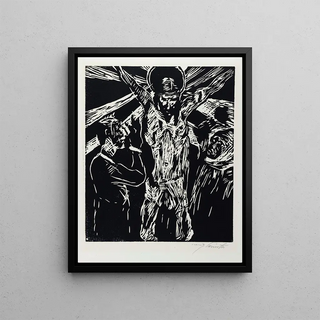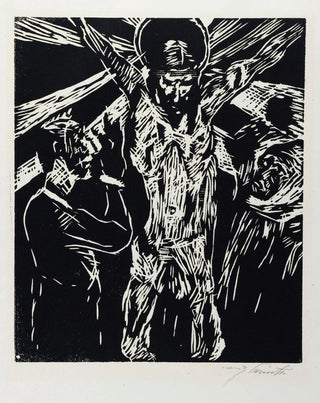Art print | The Christ on the Cross - Lovis Corinth


View from behind

Frame (optional)
Art print of The Christ on the Cross - Lovis Corinth – Captivating Introduction
In the fascinating universe of art, some works transcend time and space, captivating souls with their emotional intensity and spiritual depth. "The Christ on the Cross" by Lovis Corinth falls into this category of works that, through their visual power, manage to touch the hearts of viewers. This painting, both dramatic and serene, evokes suffering and sacrifice, while offering a reflection on transcendence and redemption. The depiction of Christ, suspended between heaven and earth, invites deep contemplation, seeking meaning beyond pain. Light and shadow play a crucial role in this composition, accentuating the emotion and spirituality emanating from the canvas.
Style and uniqueness of the work
Lovis Corinth, master of the expressionist movement, stands out for his bold use of colors and forms. In "The Christ on the Cross," he reinvents the classic scene of the crucifixion by infusing it with new energy. The color palette, dominated by dark tones and luminous highlights, creates a striking contrast that inevitably draws the eye. The gesture of Christ, both powerful and vulnerable, unfolds in a dynamic that transcends mere representation to become a true emotional experience. The brushstrokes, both vigorous and delicate, convey an almost tangible movement, as if the canvas is in constant evolution. This unique approach makes the work a testament to human anguish in the face of suffering, while offering a glimmer of hope through the light emanating from the figure of Christ.
The artist and his influence
Lovis Corinth, born in 1858, is an emblematic figure of the German art scene. His career, marked by diverse influences, from realism to symbolism, contributed to shaping his distinctive style. Corinth was not afraid to explore deep and complex themes, often related to spirituality and humanity. His work on "The Christ on the Cross" reflects a desire to reinterpret classical motifs in light of his era. By integrating elements of

Matte finish

View from behind

Frame (optional)
Art print of The Christ on the Cross - Lovis Corinth – Captivating Introduction
In the fascinating universe of art, some works transcend time and space, captivating souls with their emotional intensity and spiritual depth. "The Christ on the Cross" by Lovis Corinth falls into this category of works that, through their visual power, manage to touch the hearts of viewers. This painting, both dramatic and serene, evokes suffering and sacrifice, while offering a reflection on transcendence and redemption. The depiction of Christ, suspended between heaven and earth, invites deep contemplation, seeking meaning beyond pain. Light and shadow play a crucial role in this composition, accentuating the emotion and spirituality emanating from the canvas.
Style and uniqueness of the work
Lovis Corinth, master of the expressionist movement, stands out for his bold use of colors and forms. In "The Christ on the Cross," he reinvents the classic scene of the crucifixion by infusing it with new energy. The color palette, dominated by dark tones and luminous highlights, creates a striking contrast that inevitably draws the eye. The gesture of Christ, both powerful and vulnerable, unfolds in a dynamic that transcends mere representation to become a true emotional experience. The brushstrokes, both vigorous and delicate, convey an almost tangible movement, as if the canvas is in constant evolution. This unique approach makes the work a testament to human anguish in the face of suffering, while offering a glimmer of hope through the light emanating from the figure of Christ.
The artist and his influence
Lovis Corinth, born in 1858, is an emblematic figure of the German art scene. His career, marked by diverse influences, from realism to symbolism, contributed to shaping his distinctive style. Corinth was not afraid to explore deep and complex themes, often related to spirituality and humanity. His work on "The Christ on the Cross" reflects a desire to reinterpret classical motifs in light of his era. By integrating elements of






